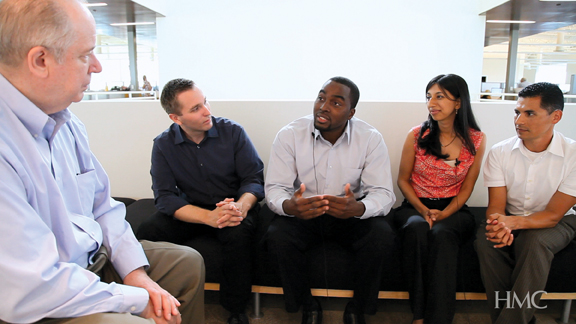“We take a multifaceted approach to professional development,” says Pasqual V. Gutierrez, AIA, Director of Architecture. Among HMC’s career development programs:
• IDP Forum, held once a month for those employees who are fulfilling the Intern Development Program. “We use the AIA Emerging Professional Companion in combination with specs of real HMC projects, so that they learn about specifications but also our HMC protocols,” says Gutierrez.
• After-hours study programs for employees preparing for the Architectural Registration Exam are supported by senior architects.
• Accessibility Workshop: a five-hour program held in odd-numbered years for employees—and clients—who need to meet state licensure renewal requirements for Mandatory Accessibility coursework.
• Access to 1,040 hours of the AIA Virtual Convention for 80 licensed architects at the firm to view and earn AIA/CES learning units.
The Emerging Leaders Forum is a two-year “corporate overlay experience” program for mid- and upper-level management-track staff to hone their corporate governance skills. Emerging leaders engage in reading assignments, community service, and professional practice mentoring sessions to help them refine their practical skills while providing insight into executive management.
At the top level, Principals, Associate Principals, and Senior Project Managers are provided a reimbursable allowance for conferences and books, plus each studio managing principal receives a discretionary fund to administer education and training for technical and administrative staff.
In what may be a unique offering, HMC recorded a thousand hours of its own lunch-and-learn “Back2Basics” learning workshops—covering such topics as BIM and cost controls—and contracted with the AIA to make them available online to HMC staff for continuing education credits.
Two employee-initiated forums meet after hours to explore issues in design, take field trips, make presentations, and enter competitions, all on their own time.
Every September, HMC’s ArchLab takes a group of 20 or so employees into the woods for a weekend retreat to dig into sustainability. “We don’t talk about LEED,” says Gutierrez. “We talk about high-performance architecture and the strategies you need to deliver it.”
More at: www.BDCnetwork.com/HMC/Careers. +
Related Stories
| Jul 21, 2014
Designing the process of leadership transition
Transition planning can be one of the more complex challenges that firms face. Effective plans begin by determining the gap between a firm’s current state and the future it envisions for itself. SPONSORED CONTENT
| Jul 21, 2014
16 utility questions to answer during your building project
We need electricity to power our building projects, along with water and gas and a faultless sanitation system. That’s what we think about when we think about utility requirements for our building project, but are we missing something? SPONSORED CONTENT
| Jul 21, 2014
Commercial real estate development growing at strongest pace since recovery began: NAIOP report
Industrial, warehousing, office, and retail sectors see strong gains; Texas leads the nation in construction-value stats.
| Jul 21, 2014
Economists ponder uneven recovery, weigh benefits of big infrastructure [2014 Giants 300 Report]
According to expert forecasters, multifamily projects, the Panama Canal expansion, and the petroleum industry’s “shale gale” could be saving graces for commercial AEC firms seeking growth opportunities in an economy that’s provided its share of recent disappointments.
| Jul 21, 2014
Workplace trends survey reveals generational patterns in office use
Data analysis from Mancini•Duffy indicates significant variations among age cohorts in the workplace.
| Jul 20, 2014
IPD contract saves time and money for cancer center [2014 Building Team Awards]
Partners share the risk and reward of extreme collaboration on this LEED Silver project, which relies heavily on Lean principles.
| Jul 20, 2014
Why every major U.S. city should be nurturing ‘Innovation Hubs’
Today, more than ever, tech districts are the key to economic growth for metro markets. A new report from the Brookings Institution calls tech hubs the superchargers of innovation economies and creators of highly coveted tech jobs.
| Jul 18, 2014
Contractors warm up to new technologies, invent new management schemes [2014 Giants 300 Report]
“UAV.” “LATISTA.” “CMST.” If BD+C Giants 300 contractors have anything to say about it, these new terms may someday be as well known as “BIM” or “LEED.” Here’s a sampling of what Giant GCs and CMs are doing by way of technological and managerial innovation.
| Jul 18, 2014
Top Construction Management Firms [2014 Giants 300 Report]
Jacobs, Barton Malow, Hill International top Building Design+Construction's 2014 ranking of the largest construction management and project management firms in the United States.
















